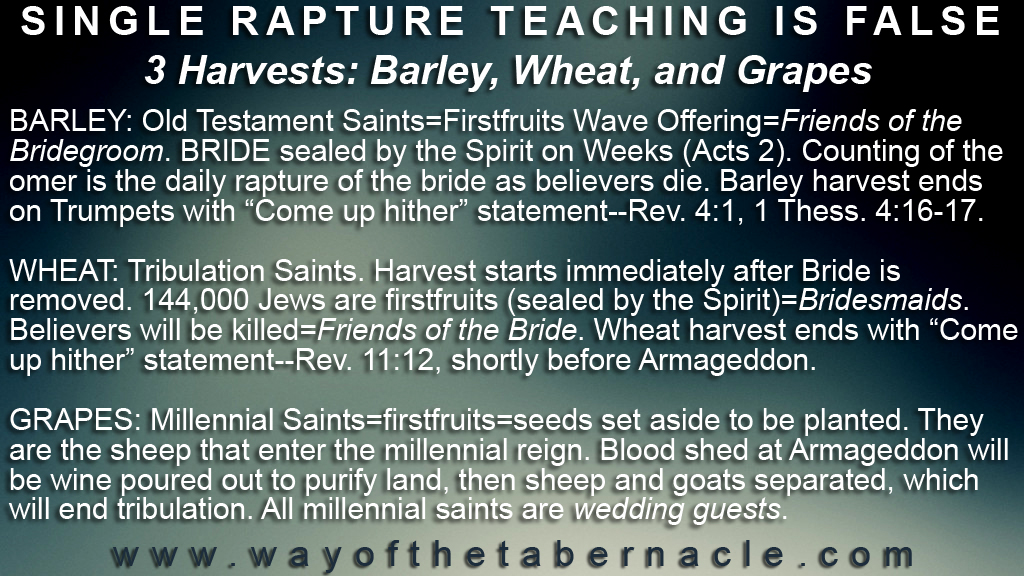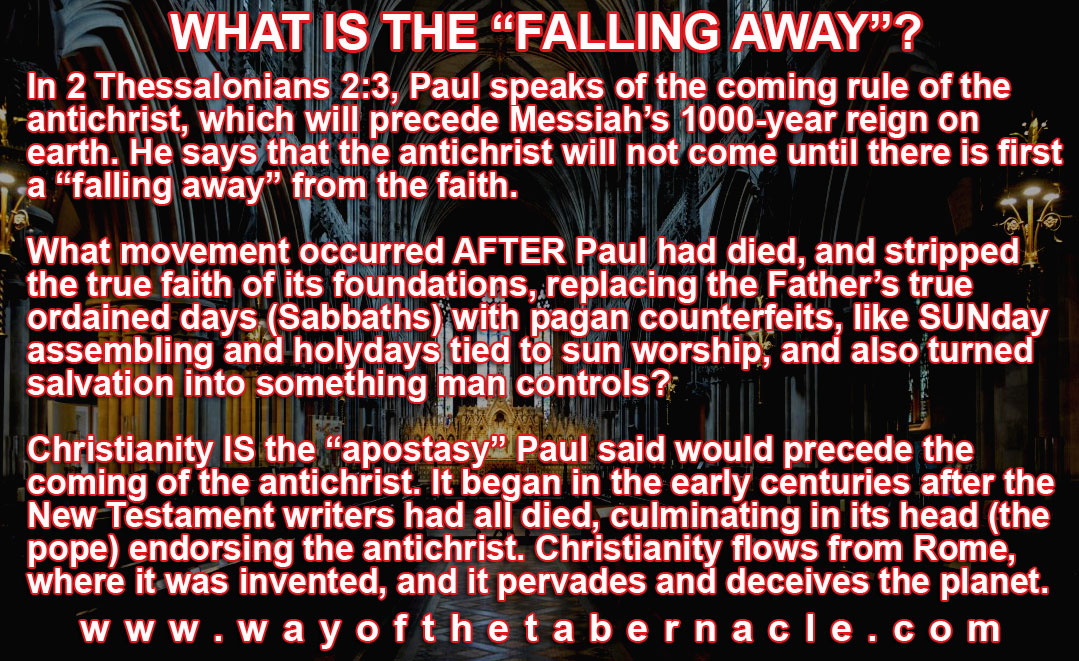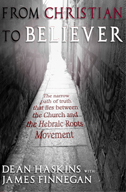Will There Be A Pre-Tribulation Rapture?
Pre-Trib? Post-Trib? Mid-Trib? Amillennial? These are all different interpretations of the scriptural texts that are given to us about prophecy—the “end times.”
Like many of the doctrines taught in the “church,” the reason there are so many different versions and interpretations comes from the fact that the “church” largely rejects the Father's traditions, and in those traditions that Paul taught the Gentile converts (2 Thessalonians 2:15), we can see the prophetic calendar as the Father has given it to us. Rest assured that, in each of those traditions that apply, the PRE-TRIBULATION rapture of the bride is shown.
The Father's ordained feasts show His prophetic calendar.
Four of the Father's ordained feasts have been fulfilled so far: Passover, Unleavened Bread, Firstfruits, and Weeks (Pentecost). Three remain: Trumpets, Atonement, and Tabernacles. The weekly Sabbath (seventh day) will not be fulfilled until the new heaven and new earth.
The Feast of Trumpets is the feast that the Jews called “the day or hour no man knows” because it is the only feast that is determined by the first sighting of the new moon by two independent witnesses. On the new moon of the month of Nisan (Passover month) the high priest had the trumpet blown to start the feast season. This was the First Trump, and for every new moon for the next six months the trumpet was blown. The new moon on the seventh month,"Tishri," is called the Last Trump and the trumpet was blown 100 Times to begin the judgment feasts, and Trumpets is the first judgment. Yah judges His house first (1 Peter 4:17). Jewish tradition teaches that those who have the Covenant of Yah will present it to Him at that feast (Revelation 4:10) after the “come up here” statement in Revelation 4:1, the presenting of the crowns.
The Feast of Trumpets is also known as The Feast of the Shout, when the high priest shouted that the new moon had been seen, and ordered that the trumpets be blown (1 Thessalonians 4:14-17). The feast is also known as the Wedding of the Messiah. To have a wedding, there must be a bride, and the Feast of Trumpets is when Messiah's bride will be gathered together with Him in the air, and brought back to the wedding chamber. The Feast of Trumpets is when the coronation of a new King is done (Revelation 5:5-9). This is when Christ receives His authority over the earth. The Feast of Trumpets is the next feast to be fulfilled on Yah's prophetic calendar.
The spiritual harvests also show the Father's prophetic calendar.
The Temple Ordinances and Practices contain a wealth of foreshadow details for us, as they describe the duties and traditions that were maintained in the temple by the priesthood. Remember, both the temple and the priesthood are foreshadows of Messiah's bride, so these things, which were administrated by the Holy Spirit in the temple, show us vivid portrayals of future spiritual real substances.
Barley Harvest
Barley was the first of the annual harvests overseen by the priests. Before the harvest began, the high priest would select one barley field that would be used for spiritual purposes, which were the daily offerings. The wave offering and the daily presenting of sheaves from the beginning to the end of the harvest (“Counting of the Omer”) would come from this one field.
The barley harvest began the first day of the week (Sunday) after the first weekly Sabbath (Saturday) following Passover, and on that day, the priest would take a sheaf of barley and present it to Yah in a wave offering, which coincided with the traditional method of harvesting barley—winnowing. Since the chaff of the barley is quite easily separated from the grain, wind was all that was necessary to harvest it; so, sheaves of barley would be waved in the air to remove the grain from the chaff, and this was the basis of the priestly wave offering. The wave offering signified the Feast of Firstfruits each year.
For seven Sabbaths from Firstfruits (49 days), the priest would daily take a sheaf of barley and present it to Yah in an offering. At the end of the 49 days, the barley harvest was concluded, and whatever barley remained was gathered up all at once.
Prophetic Significance of the Barley Harvest
Christ was crucified on Passover (the sacrifice of the perfect Lamb of Yah), and His resurrection was the firstfruits of the barley harvest. The bride of Yahoshua is symbolized by barley, and in 1 Corinthians 15, Yahoshua is identified as the “Firstfruits of those who rise from the dead.” According to the priestly practices, a group of barley stalks were selected in advance (as was Yahoshua), and were bound into a sheaf (signifying Yahoshua's captivity), and the priest would cut it from the ground just at sunset, or the beginning of the Jewish day (symbolizing Yahoshua's resurrection).
In Matthew 27:50-53, we're told that many who were dead were resurrected with Yahoshua, and were seen by several people in Jerusalem. These were the Old Testament saints who were commonly referred to as “Abraham's Bosom.” In John 20, we're told of a conversation Yahoshua had with Mary Magdalene in which He told her to stop clinging to Him, for He had not yet ascended to His Father. The significance of this statement is that, now, as the Great High Priest, He was responsible to present the spiritual wave offering to His Father. The Old Testament saints were presented by the Great High Priest Yahoshua upon His ascension to the Father.
Note the method of harvesting—winnowing, and consider the chaff surrounding the grain as a type of “flesh.” The barley grain is very easily separated from its flesh, and sacrificing/crucifying/denying the flesh is an oft-repeated admonition from Yah throughout scripture. When we get to the wheat harvest, we'll see why this method of harvest actually demonstrates the chief difference between those who are barley and those who are wheat. Of prophetic significance also is the winnowing—the tossing into the air, as 1 Thessalonians 4:17 describes this very harvesting method: Then we which are alive and remain shall be caught up together with them in the clouds, to meet the Lord in the air: and so shall we ever be with the Lord.
Wheat Harvest
The wheat harvest begins on the Feast of Weeks, which is 50 days from the Feast of Firstruits, the first day of the barley harvest. The wheat harvest does not begin until the barley harvest is complete; but, unlike barley, wheat is not as easily separated from its chaff, so it must be harvested with a method that exerts far more physical force on the grain. The instrument that was used to harvest wheat was called a “tribulum,” which was a threshing board. The tribulum had a wooden framework with bits of metal and/or flint on its underside that would actually cut and slice at the grain to remove its chaff. Following the forced separation of the outer shell from the grain, the process was then completed by winnowing.
Prophetic Significance of the Wheat Harvest
Each year, there was actually a second Passover observance that Yah ordained for those who, for whatever reason, did not have their offerings ready for the first Passover. Understanding that the barley harvest consisted of grains that were very easily separated from their flesh, the wheat harvest, by contrast, consists of those who will require a physical force to cause such separation—they will not be ready to be winnowed without first having their flesh literally cut and sliced to prepare them for the winnowing.
In Revelation 6:9-11, we read about these tribulation (tribulum) saints, and learn that they are primarily prepared to be harvested through beheading. Their flesh has not been so easily separated as to allow them to be harvested merely with winnowing alone. They arrive at their harvest through the physical cutting away of their flesh.
Grape Harvest
The grape harvest immediately followed the wheat harvest, and after picking, grapes were harvested, and most were then crushed in a wine press.
Spiritual Significance of the Grape Harvest
Those who make it through the tribulation, and then through the judgment of Atonement, will enter into the Millennial Reign of Messiah, and they will be the grape harvest. Those who end up not being deceived by Satan near the end of the millennium will enter into eternal life, and will dwell upon the new earth. Those who are deceived will be cast into the lake of fire with the devil, his demons, and the rest of humanity's unbelievers.
The barley (bride) is raptured before the tribulation begins. During the tribulation, those who proclaim Yahoshua the Messiah, will all be killed (mostly by beheading). These are the wheat. There will be a remnant at the end of the tribulation that neither took the mark of the beast, nor rose up against Jerusalem. They are the sheep that are separated from the goats, and that remnant will go into the millennial reign of Christ, and will be judged according to their belief vs. unbelief at the end of that time. They are the seeds from the grape harvest that will be planted, and will inhabit the earth during that thousand years.
While the bride is the barley, and the tribulation saints are the wheat, the millennial saints are the grapes.
So, we see according to the three prophetic harvests that the barley (bride) must first be harvested before the wheat harvest (tribulation) can begin. And, the wheat must be harvested before the grape harvest begins. Thus, the biblical harvests confirm that the bride will be removed from the earth to meet the Bridegroom in the air before the tribulation begins.
The wedding traditions as they apply to the pre-tribulation rapture of the bride.
Throughout scripture, we see the wedding traditions presented, as the entire focus of the scriptures, from start to finish, is a love story that culminates in a wedding feast celebrating the marriage of the Lamb to His bride. While it is fairly simple to search and find those Jewish wedding traditions online (actually, they're the Father's wedding traditions), there is one element of those traditions that shows, irrefutably, that Messiah's bride will be removed from the earth before the tribulation, and that is the consummation of the marriage.
Many don't even realize what scriptures actually point to the consummation of the Lamb's marriage to His bride. In John 3:29, we see John the Baptist referencing a very specific tradition that was observed in the Jewish wedding when he states, “He who has the bride is the bridegroom; but the friend of the bridegroom, who stands and hears him, rejoices greatly because of the bridegroom’s voice. So this joy of mine has been made full.”
John is speaking of the tradition where the bridegoom and bride would enter the wedding chamber to consummate their marriage (their marriage up to that point has been legal, but not physically completed yet). The best man (Hebrew: shoshben) would stand outside the wedding chamber and wait to hear the voice of the bridegroom call out, announcing that the marriage had been consummated, and then the best man would go and tell the rest of the wedding party to start preparing the wedding feast.
So, knowing that the Lamb's marriage to His bride will be consummated, where and when will that occur? You see, once the bridegroom announces to his legally-betrothed bride that he is going to prepare a dwelling place for them at his father's house, that begins a mandatory period of separation. The two cannot have direct contact again until the father tells his son to go and get his bride, and bring her back to the wedding chamber to consummate their marriage. This is what happened after Yahoshua told His disciples that He HAD to go away, and the Holy Spirit would be sent in His place. THIS is why!
Now, if Messiah's bride were not to be raptured until after the tribulation when He returns to the earth, He would be coming to where some of the bride is, while the rest is already in heaven. He cannot have direct contact with His bride until He goes to get her to consummate the marriage. Once He comes to the earth at the end of the tribulation, He will be setting up His earthly kingdom immediately after that. How could He consummate His marriage with some of the bride here, while some of the bride is in heaven? And, He does not return to heaven between the end of the tribulation and the establishment of His earthly kingdom.
Moreover, in Revelation 19, we see Yahoshua emerging from the wedding chamber BEFORE He leaves heaven to return to the earth in judgment. How could He be in the wedding chamber with His bride if part of His bride is still on earth? Answer: it is not possible. The bride must ALL be in the wedding chamber before that point.
But, again, when and where does the consummation take place? We see the bride entering heaven in Revelation 4 with the sound of the trumpet (Feast of Trumpets). The 24 elders represent the bride, as the members of the bride are the priests in heaven (1 Peter 2:9). Also, it is clear that she has already been judged for reward, which is shown by the crowns that are cast at the throne (they receive those crowns as their reward at judgment).
Revelation 8:1 speaks of silence in heaven for about half an hour. That is foreshadowed by the silence that would occur when the high priest entered the Holy of Holies wearing bells. Everyone would remain silent to hear the tinkling of those bells, assuring them that the high priest had not been struck dead by Yah. The Holy of Holies is the wedding chamber, and Yahoshua the Lamb is the Great High Priest. The silence in heaven occurs when He enters the wedding chamber to consummate His marriage to His bride, who will then, forever, rule and reign in heaven with Him as the wife of the King.
This all occurs even before Satan is cast out of heaven in Revelation 12, entering the assassinated body of the son of perdition, resurrecting him to do battle with Yahoshua at Armageddon. So, the wedding traditions show exactly what the rest of the Father's traditions show—that Messiah's bride will be raptured before the tribulation begins.
That event on the Feast of Trumpets will end the spiritual barley harvest, which then begins the spiritual wheat harvest—the tribulation. But, the typical churchian line that the rapture can happen “at anytime” does ring true in a sense, as a believer's death accomplishes the same thing, since “rapture” merely means “to carry away,” which is what also occurs at death. So, while an individual's rapture can happen at any time, if Yah calls him home by death, the corporate gathering of the rest of the bride will occur on the Feast of Trumpets (the “last trump” of 1 Corinthians 15:52), and the tribulation will begin immediately after that—the ten days from Trumpets to Atonement.
Many falsely teach that the bride will be on the earth with Messiah during His Millennial Reign, but that is not true. According to the wedding traditions, once the bride is betrothed (legally married), she is veiled whenever she goes out into the public square. Only her closest friends and family know who she is. After she is gathered to her bridegroom and the marriage is physically consummated, the bride remains in the wedding chamber until the wedding feast. That is what we see in Revelation 21:2.
The bride will not be on the earth with Messiah, but the friends of the Bridegroom (OT saints) and the friends of the bride (tribulation saints) will return with Messiah for Armageddon, and they will rule and reign on the earth for 1000 years, as they have been promised. That will be the preparation for the wedding feast. While that might seem like a long time for the bride to await the wedding feast, understand that, in heaven, a day is as a thousand years, and a thousand years is as a day (2 Peter 3:8), so, to the bride, it will merely be a day of preparation for the wedding feast. That feast will be in the new heaven, and is actually the essence of eternal life. All of eternity will be a wedding celebration!
One additional note: within the friends of the bride, there is a group who are sealed just as the bride was sealed, and are the bride's support--the ones who work the harvest in the wheat field. They are the bridesmaids. There will be 144,000 of them (12,000 from each of the 12 physical tribes), and they will all be virgin men who are physical Jews. In eternity, they will be the pillars (support) within the New Jerusalem, who is the bride. This will be the fulfillment of the two groups being brought together as one (Ephesians 2:16). Those to whom Messiah was speaking in Matthew 24, who were physical Jews, are a foreshadow of this group.
The rest of the wheat harvest will not be sealed by the Holy Spirit as the bride is, but will receive His covering at the moment of their deaths. That is why they must "endure to the end." Satan, as the antichrist, will kill off whatever of them remain ten days before Armageddon, on the Feast of Trumpets, which is the "come up hither" statement we see in Revelation 11:12, and that will end the wheat harvest, just as that same statement ended the barley harvest in Revelation 4:1. Armageddon will occur on the Feast of Atonement, ten days after the remaining wheat are winnowed.
To see the events AFTER the bride is removed, and how those events will all occur on Yah's ordained Sabbaths, CLICK HERE.


Salvation
Traditions
Other Truths
But now in Yahoshua the Messiah you who formerly were far off have been brought near by the blood of Christ. For He Himself is our peace, who made both groups into one and broke down the barrier of the dividing wall, by abolishing in His flesh the enmity, which is the Law of commandments contained in ordinances, so that in Himself He might make the two into one new man, thus establishing peace, and might reconcile them both in one body to Yah through the cross, by it having put to death the enmity. Ephesians 2:13-16




